Top Vapi AI Alternatives for Voice Automation 2025
Discover leading Vapi AI alternatives for 2025, compare top platforms for voice automation, faster setup, better pricing, and advanced conversational features.

Akshat Mandloi
Updated on
December 26, 2025 at 11:30 AM
Voice agents are picking up calls, answering questions, and handling tasks for more teams than ever, no need to repeat yourself or wait on hold. They work across digital products and support lines, giving brands a consistent presence while helping teams work smarter.
Vapi AI brought flexible, developer-friendly voice tech to the table. Still, sometimes you need lower costs, easier connections with older systems, more language options, or tighter control over conversations. That’s why a lot of folks explore Vapi AI alternatives; they want a better fit or more features for their setup.
This blog will go through the best Vapi AI alternatives for 2025, highlight where each stands out, and compare features that matter. Skip the hype and find what works for you.
Key Takeaways
Performance & Cost Issues Drive Teams to Seek Alternatives: Vapi AI users often look elsewhere due to call lag, robotic voice quality, and higher costs as usage scales.
Alternatives Excel in Specialized Areas: Competitors like Smallest.ai and Voiceflow offer strengths such as fast, natural voices, strong no-code tools, and advanced conversation capabilities.
Integration & Customization Levels Differ: Some platforms have smooth CRM/telephony integration and flexible workflow tools, making them easier to adapt to existing business systems.
Diverse Pricing & Free Trials: Pricing ranges from usage-based to hybrid/subscription models; several platforms provide meaningful free tiers for live testing before purchase.
Match Platform Strengths to Your Needs: Best results come from mapping each platform’s unique features (language, compliance, logic control, support) to your technical and operational requirements.
What are AI Voice Agents?
AI Voice Agents are interactive systems that automate spoken conversations using advanced speech synthesis, speech recognition, and natural language processing. These agents handle calls and spoken requests, deliver information, process transactions, and respond to inquiries, functioning in everything from digital call centers to voice-activated customer service lines, branded audio experiences, or self-service support platforms.
Here are the Technical Considerations for Developers;
APIs and SDKs: Most providers offer strong language models, cloud APIs, and SDKs, enabling integration with CRM, helpdesk platforms, databases, and backend systems for smooth data handoff and workflow automation.
Customization: Developers can define conversation flows via visual builders, dialog scripting languages, or programmable logic. Some advanced frameworks support integrating custom NLU models or importing external datasets.
Multimodality & Channel Reach: Deploy to SIP trunks, telephony carriers, web widgets, or embed directly in mobile apps, enabling reach across traditional and digital touchpoints.
Scalability: Cloud-native architectures and auto-scaling capabilities make it possible to handle seasonal spikes and large campaigns without infrastructure bottlenecks.
Quick Overview About Vapi AI
Vapi AI is a platform for building, deploying, and managing AI voice agents, systems that automate spoken conversations between people and businesses using synthetic voices and advanced language models. It targets technical teams and organizations that want to add automated voice interaction to their existing products, services, or customer operations.
Technical and Functional Approach

Here’s how it functions when you bring it into your operation:
API-Driven: Vapi’s API and SDK allow direct integration with telephony, CRM, databases, and backend systems, enabling programmatic call handling without custom speech or conversation logic.
Custom Dialogue: Tools for scripting call flows and integrating custom NLU let teams handle specialized terminology or complex intents.
Voice Quality: Neural text-to-speech supports realistic, branded voices in multiple languages and accents.
Flexible Routing: Calls route through PSTN, SIP, or WebRTC, compatible with both traditional and digital phone systems.
Cloud Scale: Automated scaling handles high and variable call volumes, removing manual infrastructure management.
Vapi AI addresses many voice application needs, but teams with particular requirements, around speed, simplicity, or voice choices, often find it helpful to consider a few other platforms. Here’s a quick look at the main alternatives for 2025.
Top Vapi AI Alternatives for 2025
If you’re eyeing platforms that pick up where Vapi AI leaves off, the difference comes down to features that stand out at scale and in real projects, not just a new set of settings. Here’s how the 2025 alternatives stack up for teams who want voice AI that fits demanding workflows:
1. Smallest.ai
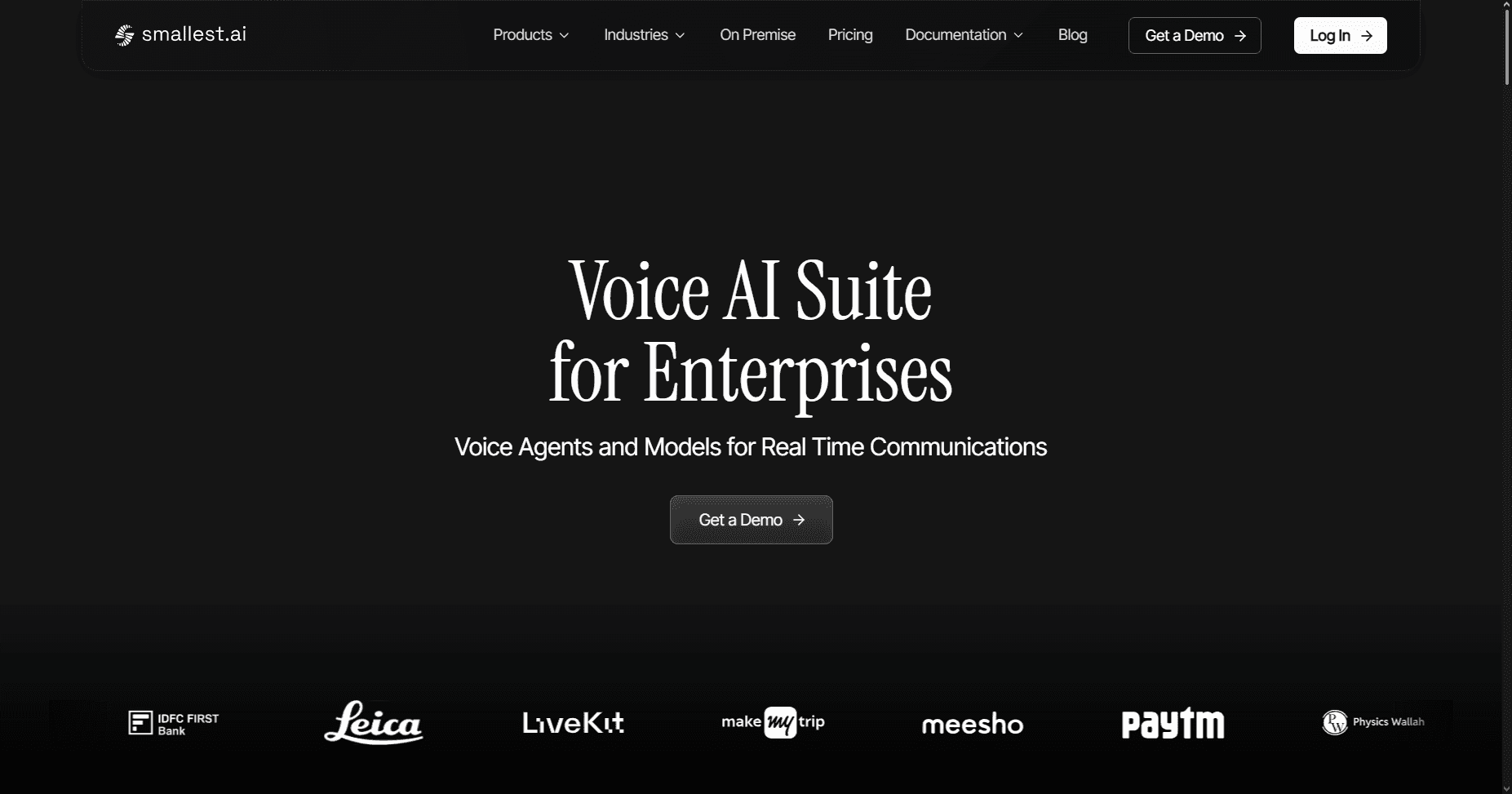
Smallest.ai operates as a real-time AI platform specifically engineered for voice and conversational technologies, delivering studio-quality text-to-speech synthesis with exceptional speed and accuracy. The platform distinguishes itself through its proprietary Lightning TTS model, which achieves sub-100ms response times while maintaining natural voice quality that closely mimics human speech patterns.
Ideal for: Businesses requiring high-volume call automation with minimal latency, content creators needing consistent voiceovers, and developers building real-time voice applications.
Key Features:
Ultra-Low Latency for Real-Time Voice: Smallest.ai delivers highly responsive text-to-speech with real-world end-to-end latency averaging around 336 ms, enabling natural, interruption-free conversations in customer service and voice apps.
High-Quality Voice Cloning Requires Longer Audio: Creating a personalized AI voice clone needs about 10 seconds of clean audio input, not 3-5 seconds, ensuring better fidelity and reliability for branded voices.
Supports 16+ Languages with Quality, Not Volume: The platform currently supports 16+ languages, including English variants, Hindi, Arabic, and several European and Indian languages, focusing on voice quality and expressiveness rather than vast language breadth.
Pricing is Character-Based with Additional Cloning Costs: TTS pricing ranges roughly $0.07–$0.08 per minute of speech, with voice cloning billed separately (~$0.045/min), reflecting a more complex pricing structure than some competitors.
Enterprise-Grade Security & Compliance: Meets SOC 2, HIPAA, and GDPR standards with encryption, data residency options, and audit logging, making it suitable for regulated industries like healthcare and finance.
Trade-offs: Speed & Quality vs. Variety and Usability: While excelling in fast, natural synthesis (8.7/10 voice quality score), Smallest.ai offers fewer voice options and a steeper learning curve compared to rivals like ElevenLabs, which have larger voice libraries and simpler interfaces.
2. ElevenLabs
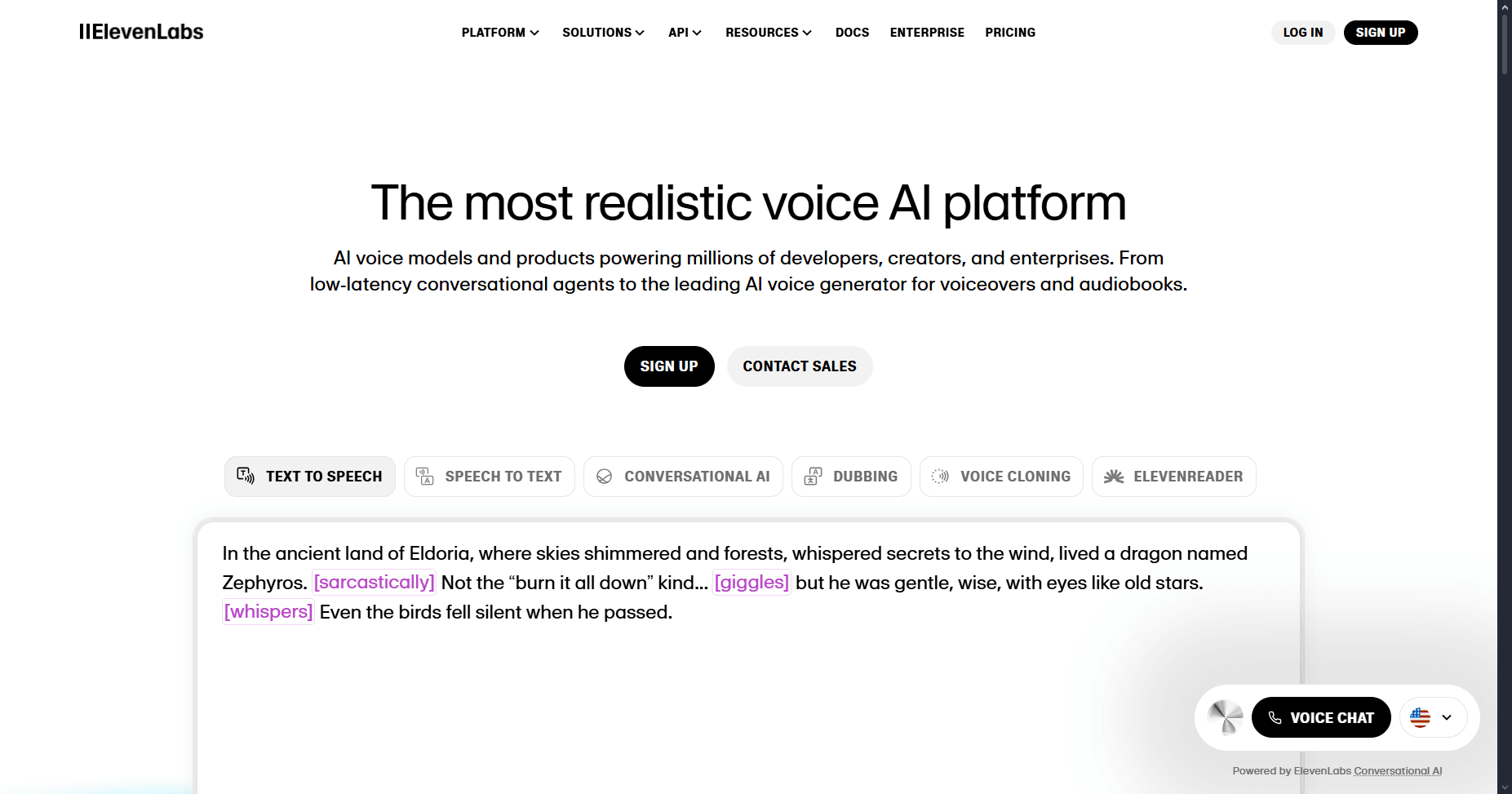
ElevenLabs represents the current industry standard for high-quality AI voice generation, offering advanced text-to-speech capabilities with remarkable naturalness and emotional expression. The platform has gained widespread adoption among content creators, developers, and enterprises seeking premium voice synthesis solutions with extensive customization options.
Ideal for: Content creators requiring professional-quality voiceovers, businesses needing multilingual voice capabilities, and applications demanding the highest audio fidelity.
Key Features:
Industry-Leading Voice Quality: Generates speech that closely mimics human vocal characteristics with natural intonation and emotional depth.
Advanced Voice Cloning: Creates custom voices using minimal audio samples with professional-grade accuracy.
Multiple Voice Models: Provides Flash v2.5 for ultra-low latency and Multilingual v2 for highest quality output.
Professional API Integration: Supports various audio formats, including MP3, PCM for telephony applications.
Commercial Licensing: Includes usage rights for business applications across different pricing tiers.
Read more: TTS Benchmark 2025: Smallest.ai vs ElevenLabs Report
3. PolyAI

PolyAI specializes in building enterprise-grade voice assistants capable of handling complex customer service interactions with human-like conversation quality. The platform focuses on contact center automation, enabling businesses to resolve over 50% of customer calls automatically while maintaining natural dialogue flow and contextual understanding.
Ideal for: Large enterprises with high-volume customer service operations, hospitality and retail businesses, and organizations requiring multilingual customer support.
Key Features:
Human-Level Conversational AI: Understands customer intent regardless of phrasing or accent variations.
Multi-Channel Integration: Operates across voice, web, and messaging platforms with smooth transitions.
Real-Time Analytics: Provides comprehensive performance monitoring and conversation insights.
Custom Voice Personas: Creates branded voice personalities that align with company identity.
24/7 Availability: Handles customer inquiries around the clock without human intervention.
4. Synthflow AI
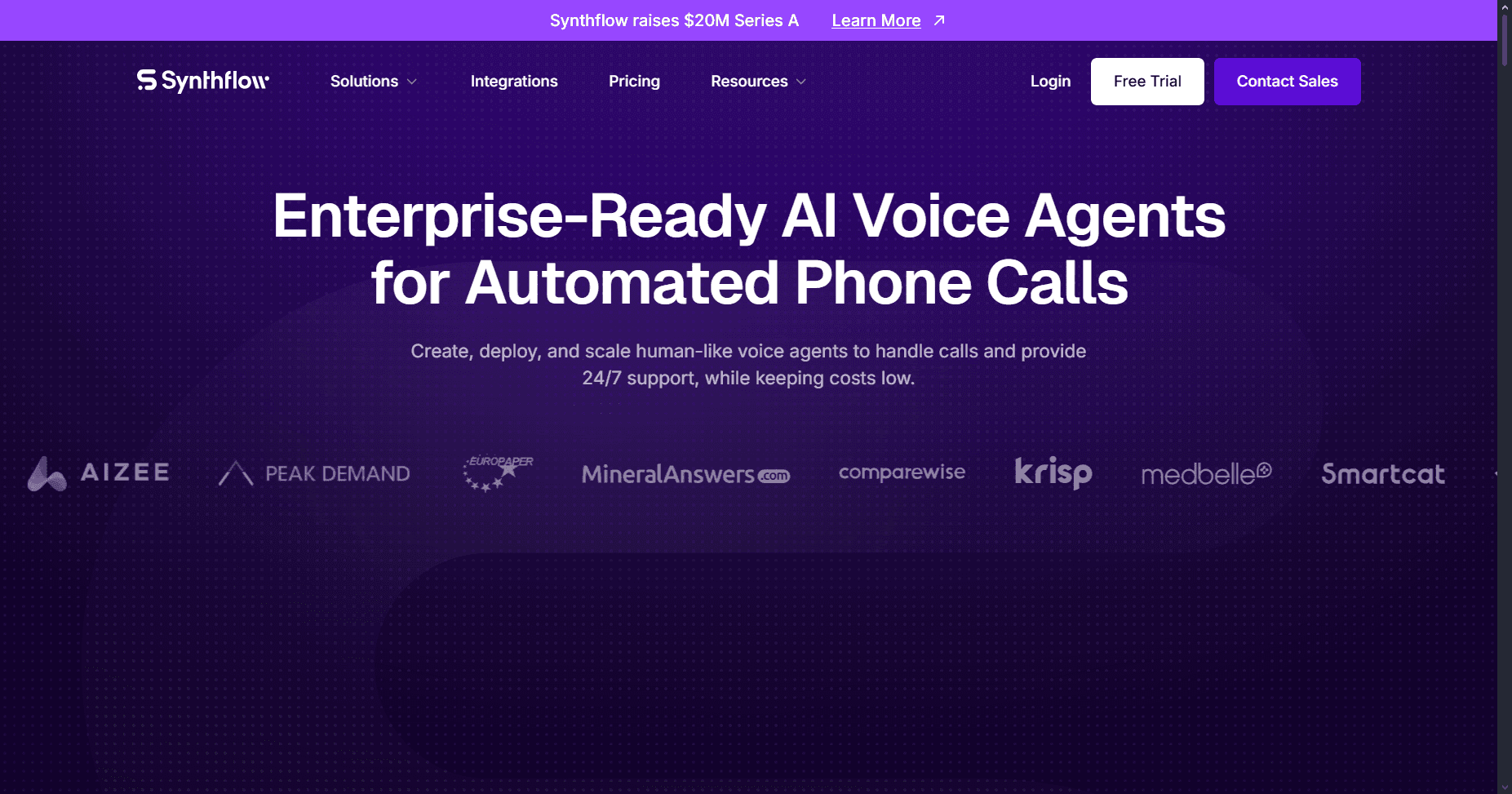
Synthflow AI positions itself as a comprehensive no-code platform for creating AI voice agents that handle both inbound and outbound calling scenarios. The platform emphasizes ease of use while providing enterprise-grade capabilities for businesses seeking to automate phone-based customer interactions without technical expertise.
Ideal for: Small to medium businesses requiring quick deployment, agencies managing multiple clients, and teams without extensive technical resources.
Key Features:
No-Code Agent Builder: Creates advanced voice agents using a drag-and-drop interface without programming knowledge.
Multi-Language Support: Operates in 10+ languages with native accent recognition.
CRM Integration: Connects with 200+ business tools, including HubSpot, Salesforce, and Zapier.
Real-Time Call Handling: Manages concurrent conversations with natural speech patterns.
Custom Workflow Automation: Builds complex call flows with conditional logic and API integrations.
White-Label Platform: Offers agency-friendly infrastructure for reselling voice services.
5. Twilio Voice
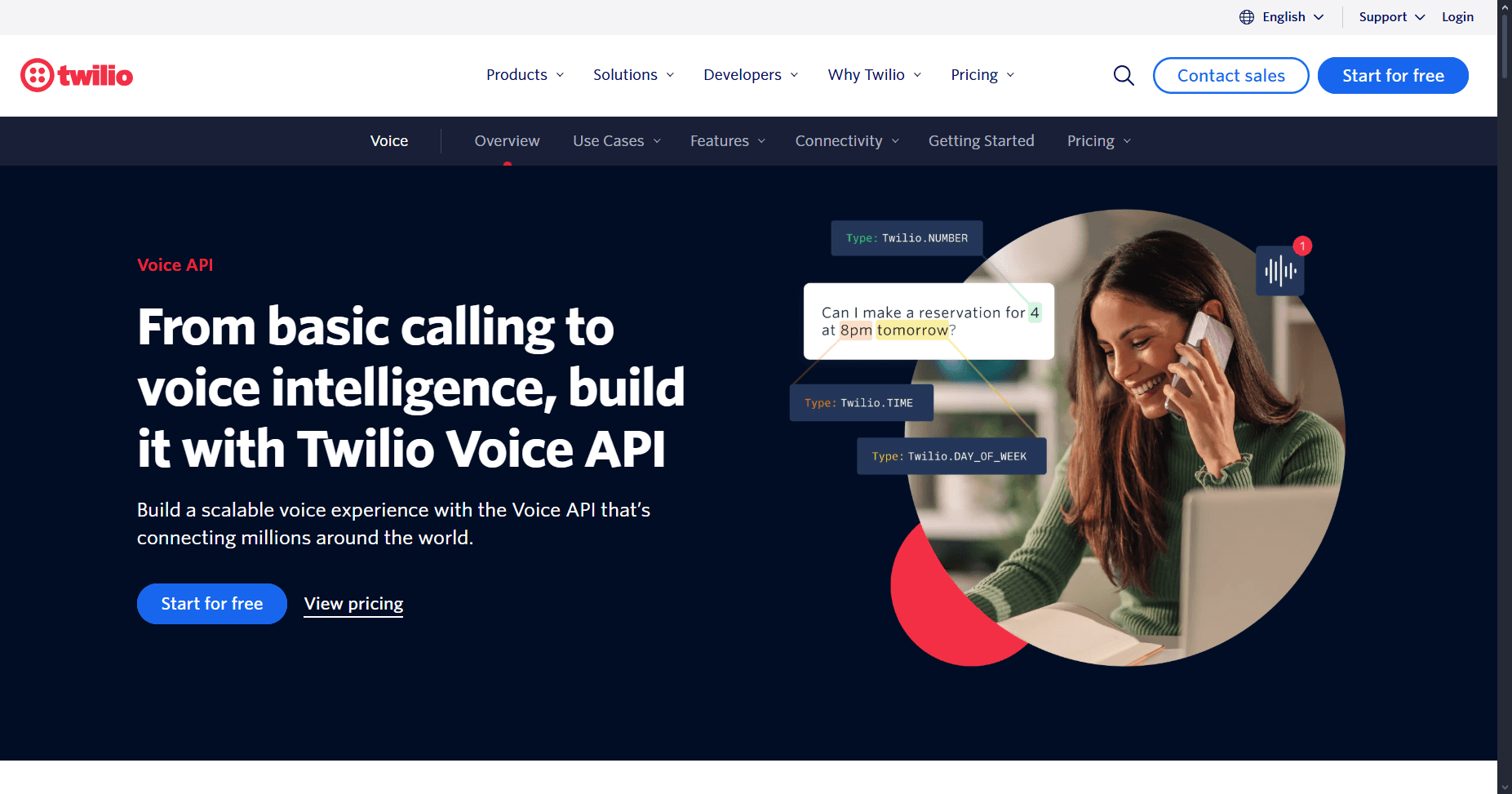
Twilio Voice provides the foundational infrastructure for building custom voice applications through comprehensive APIs and global telecommunications connectivity. Rather than offering pre-built AI agents, Twilio empowers developers to create customized voice solutions with complete control over functionality and user experience.
Ideal for: Developers building custom voice applications, enterprises requiring specific telephony integrations, and businesses needing global communication infrastructure.
Key Features:
Global Voice Connectivity: Provides reliable calling infrastructure across 100+ countries with local number availability.
Programmable Call Control: Enables custom call routing, recording, and management through comprehensive APIs.
TwiML Markup Language: Offers a simple XML-based language for defining call behavior and interactions.
Voice Intelligence: Includes AI-powered transcription, sentiment analysis, and call insights.
SIP Integration: Supports existing telephony infrastructure through SIP trunking capabilities.
Real-Time Communication: Enables browser and mobile-based voice calling through WebRTC.
6. Alan AI
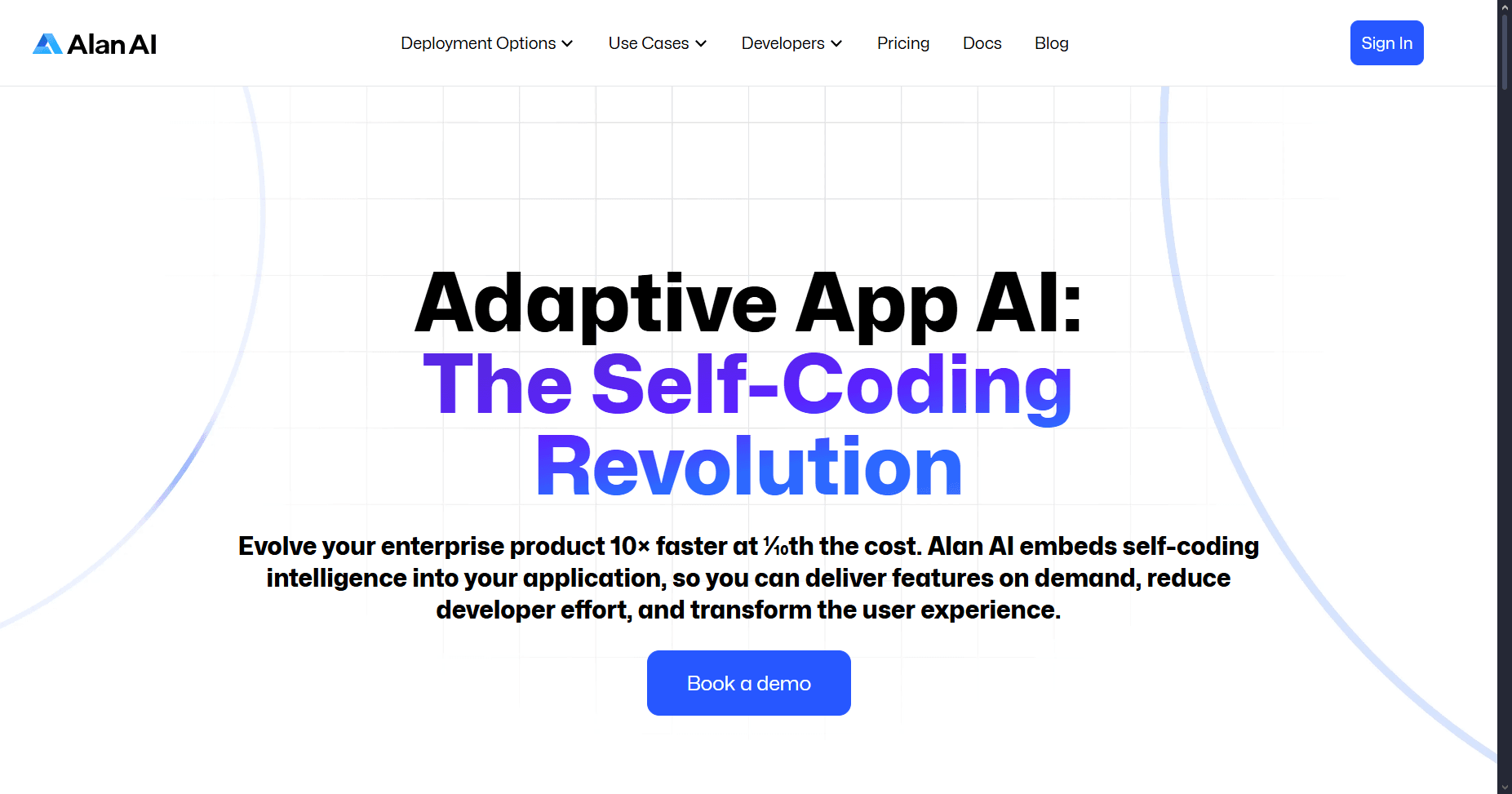
Alan AI operates as an application-level AI platform that embeds intelligent interfaces directly into existing applications rather than providing standalone voice agents. The platform focuses on creating agentic experiences that understand application context and can perform complex tasks through natural language interactions.
Ideal for: Enterprise applications requiring deep integration, mobile and web developers seeking intelligent interfaces, and businesses wanting AI embedded within existing workflows.
Key Features:
Cross-Platform SDKs: Supports Web, iOS, Android, and popular frameworks including React, Angular, and Vue.
Application Context Awareness: Understands app structure and can perform actions within the application interface.
Multi-Modal Interactions: Combines voice, text, and visual elements for comprehensive user experiences.
Enterprise Deployment Options: Offers SaaS, VPC, and on-premises deployment models.
Real-Time Updates: Pushes changes to AI behavior without requiring app updates or redeployment.
7. Voiceflow
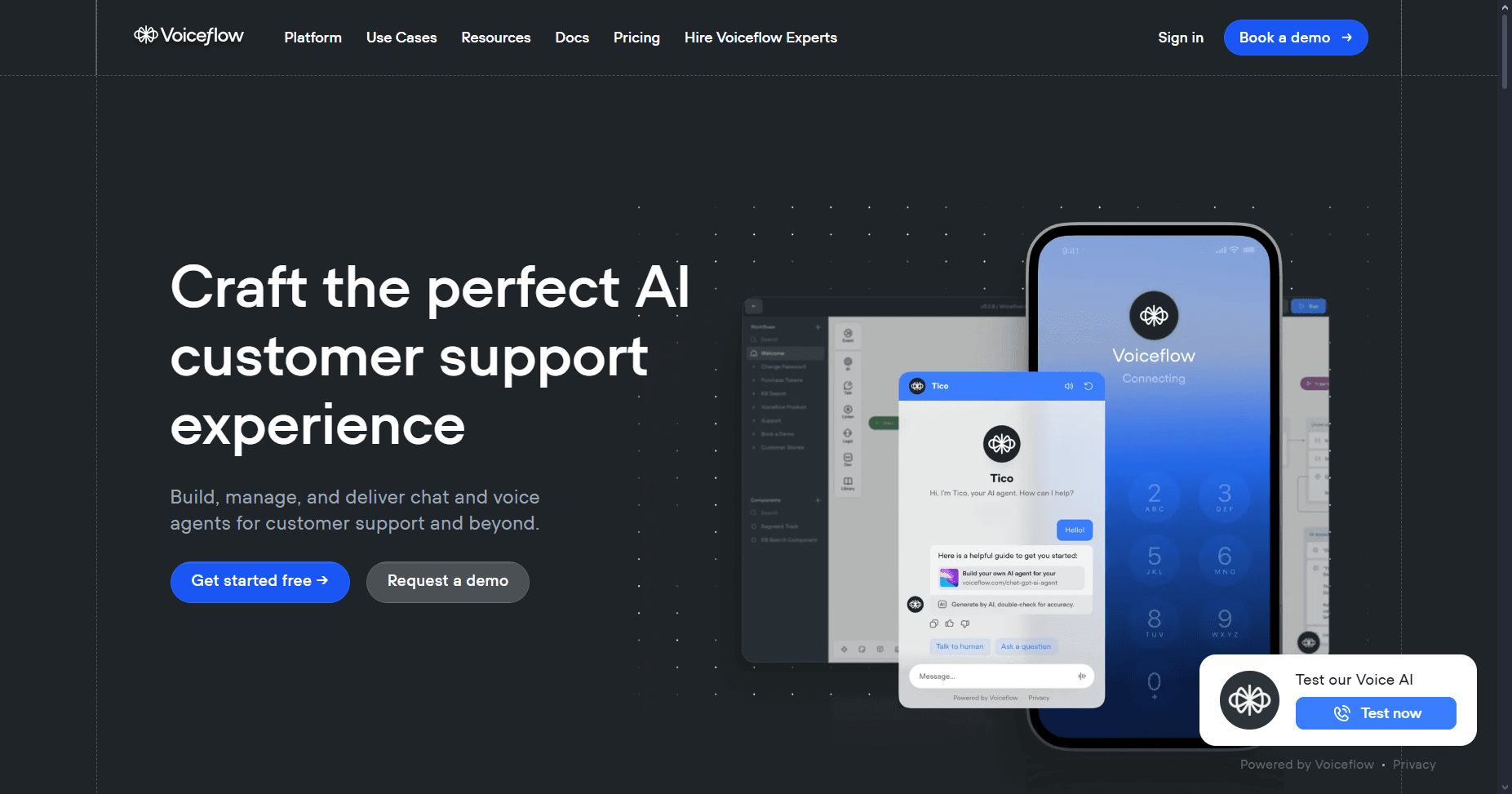
Voiceflow provides a comprehensive platform for designing, prototyping, and deploying conversational AI experiences through a visual drag-and-drop interface. The platform emphasizes collaborative development, enabling teams to create advanced chat and voice agents without extensive programming knowledge.
Ideal for: Teams requiring collaborative development environments, businesses needing rapid prototyping capabilities, and organizations wanting comprehensive conversation management tools.
Key Features:
Visual Workflow Builder: Creates complex conversation flows using an intuitive drag-and-drop interface.
Multi-Channel Deployment: Publishes agents across websites, mobile apps, and voice platforms.
Knowledge Base Integration: Trains agents on custom data sources with vector database support.
Team Collaboration: Supports real-time editing, commenting, and version control for distributed teams.
Custom Integrations: Connects with business systems through APIs and webhooks.
Price Comparison of Vapi AI Alternatives
After sizing up how these alternatives stack up on features, here’s where the numbers land for 2025:
Platform | Entry-Level Plan | Mid-Tier / Growth | Top Standard Tier |
|---|---|---|---|
Vapi AI | No free tier; $10 trial credits | Orchestration fee $0.05/min (+ telephony) | Enterprise – custom quote |
Smallest.ai | Free – $1 in free test credits | Basic $49.00; Premium $1,999.00 | Enterprise – custom quote |
ElevenLabs | Free – 10 k credits (≈10 min TTS) | Starter $5; Creator $22; Pro $99 | Scale $330; Business $1,320 |
PolyAI | No published self-serve tier | Contact Sales | Contact Sales |
Synthflow AI | $29/mo– 50 min & 5 conc. calls | pro– $375/mo Growth- $750/mo | Agency – $1,250/mo Enterprise- Custom |
Twilio Voice | Free trial available Pay-as-you-go – no monthly fee | Pay-as-you-go Voice pricing | Pay-as-you-go Voice pricing |
Alan AI | Contact sales | Contact sales | Contact sales |
Voiceflow | Starter Free (100 credits) | Pro $60/mo (or $648/yr) | Business $150/mo (or $1,620/yr); Enterprise custom |
Top Vapi AI alternatives for 2025 each have their own accent, speed, simplicity, voice options, but sometimes teams need to look further to match their specific priorities. That’s where considering why organizations explore beyond Vapi AI starts to matter. Here’s what drives those decisions:
Why Organizations Look for Vapi AI Alternatives
Even teams that value Vapi AI’s developer flexibility sometimes reach a point where specific operational needs or changing expectations push them to look further. Here’s what you find when you step back and consider what people look for in alternatives, not feature parity, but real gaps and practical priorities:
Cost: Pricing may not suit budgets, especially for variable call volumes or smaller operations.
Integration: Some need deeper compatibility with existing telephony or business systems than Vapi provides.
Language/Region: Global or niche markets may require broader language, dialect, or regulatory support.
Customization: Advanced users sometimes seek greater control over AI behavior, data, or compliance.
Scalability: Certain industries require proven performance under extreme, sustained call volumes.
Security/Compliance: Highly regulated sectors may need certifications, on-prem options, or stricter audit trails.
Tech Stack Alignment: Native integrations with current tools can reduce development overhead.
Support/SLAs: Mission-critical operations often demand stronger uptime guarantees and responsive support.
Feature Set: Teams may look for broader capabilities (analytics, omnichannel, sentiment analysis) not fully covered by Vapi.
Dev Experience: If Vapi’s tooling or documentation doesn’t fit internal workflows, developers may seek alternatives with better compatibility.
Knowing the reasons teams seek out alternatives is the first step; the next is narrowing in on which platform fits your priorities and use case. Here’s how to make that call.
How to Choose the Best Vapi AI Alternative
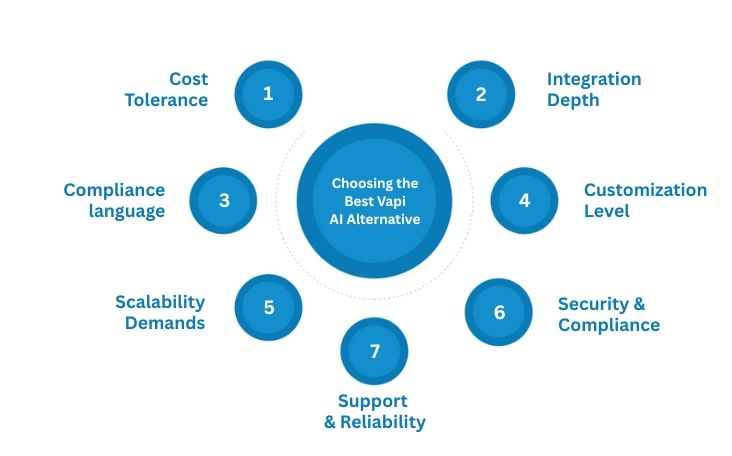
Given the options and your own goals, choosing a Vapi AI alternative comes down to matching core features to the specific ways your team operates, not just features on a page, but how those features translate into your daily workflow. Here’s what separates platforms that “could” work from those that do:
Cost Tolerance: Know your budget range and how call volume fluctuations affect expenses. Compare pricing models; some platforms charge per minute, per call, or offer flat rates that better fit your usage patterns.
Integration Depth: List the systems that need to connect with your voice solution. Check if alternatives offer native plugins or APIs that work with your existing telephony, CRM, or analytics tools without requiring custom code.
Language and Compliance Needs: If you serve global or specialized markets, verify support for required languages, dialects, and local regulations. Some platforms excel in specific regions or industries.
Customization Level: Determine how much control you need over conversation logic, AI models, and data handling. Open-source or developer-centric platforms may provide more flexibility for unique workflows.
Scalability Demands: Test for performance under peak load. Platforms with a track record in your industry, especially during high-traffic periods, are often a safer bet.
Security and Compliance: For regulated sectors, confirm certifications (HIPAA, GDPR, etc.), encryption standards, and whether the platform supports on-premises deployment if required.
Support and Reliability: Assess the quality of technical support and uptime guarantees. Organizations with mission-critical operations should prioritize vendors with strong SLAs and responsive service.
Conclusion
The tricky thing with voice automation platforms, including Vapi AI and its competitors, is that the real value comes not from a flashy demo or a long feature list, but from how the tool fits (or not) with your daily workflow, existing systems, and real-world call volumes. The right pick often comes down to a handful of practical details: how flexible it is with your tech stack, whether it can handle your quirks and compliance needs, and how you can see what’s happening with calls and conversations. That’s where deployment headaches get lighter and results get better.
If you’re looking for a direct, developer-first voice agent platform, where you get straightforward integration, clear controls, and support from actual technical people, take a close look at smallest.ai. You’ll find a platform that syncs up with your systems, runs smoothly even under stress, and gets out of your way when you need to build. Request a demo today.
FAQs About Vapi AI Alternatives
1. Why do some teams notice call lags or performance dips with Vapi AI?
Vapi AI has been reported to introduce noticeable call lag, especially after the first 15–20 seconds of conversation, which can impact user experience during longer sessions.
2. Are there platforms focused on no-code conversation design?
Yes, some Vapi AI alternatives put a strong emphasis on no-code design, letting teams build complex conversation flows without developer resources, ideal for rapid prototyping or non-technical users.
3. Do any alternatives offer truly free trials or significant free tiers?
A few alternatives let you run live voice AI sessions on a free tier or trial, giving you time to test features and performance with real calls before any commitment.
4. How do Vapi AI alternatives handle integration with CRMs or existing business tools?
Integration depth varies; some platforms offer built-in support for major CRMs and analytics systems, while others rely solely on API connections, which might require extra custom work to align with existing workflows.
5. What are common user complaints that drive people from Vapi AI to alternatives?
The most consistent drawbacks cited are high costs relative to volume, robotic-sounding voices, and limited customization for advanced business needs, especially at scale.
Voice agents are picking up calls, answering questions, and handling tasks for more teams than ever, no need to repeat yourself or wait on hold. They work across digital products and support lines, giving brands a consistent presence while helping teams work smarter.
Vapi AI brought flexible, developer-friendly voice tech to the table. Still, sometimes you need lower costs, easier connections with older systems, more language options, or tighter control over conversations. That’s why a lot of folks explore Vapi AI alternatives; they want a better fit or more features for their setup.
This blog will go through the best Vapi AI alternatives for 2025, highlight where each stands out, and compare features that matter. Skip the hype and find what works for you.
Key Takeaways
Performance & Cost Issues Drive Teams to Seek Alternatives: Vapi AI users often look elsewhere due to call lag, robotic voice quality, and higher costs as usage scales.
Alternatives Excel in Specialized Areas: Competitors like Smallest.ai and Voiceflow offer strengths such as fast, natural voices, strong no-code tools, and advanced conversation capabilities.
Integration & Customization Levels Differ: Some platforms have smooth CRM/telephony integration and flexible workflow tools, making them easier to adapt to existing business systems.
Diverse Pricing & Free Trials: Pricing ranges from usage-based to hybrid/subscription models; several platforms provide meaningful free tiers for live testing before purchase.
Match Platform Strengths to Your Needs: Best results come from mapping each platform’s unique features (language, compliance, logic control, support) to your technical and operational requirements.
What are AI Voice Agents?
AI Voice Agents are interactive systems that automate spoken conversations using advanced speech synthesis, speech recognition, and natural language processing. These agents handle calls and spoken requests, deliver information, process transactions, and respond to inquiries, functioning in everything from digital call centers to voice-activated customer service lines, branded audio experiences, or self-service support platforms.
Here are the Technical Considerations for Developers;
APIs and SDKs: Most providers offer strong language models, cloud APIs, and SDKs, enabling integration with CRM, helpdesk platforms, databases, and backend systems for smooth data handoff and workflow automation.
Customization: Developers can define conversation flows via visual builders, dialog scripting languages, or programmable logic. Some advanced frameworks support integrating custom NLU models or importing external datasets.
Multimodality & Channel Reach: Deploy to SIP trunks, telephony carriers, web widgets, or embed directly in mobile apps, enabling reach across traditional and digital touchpoints.
Scalability: Cloud-native architectures and auto-scaling capabilities make it possible to handle seasonal spikes and large campaigns without infrastructure bottlenecks.
Quick Overview About Vapi AI
Vapi AI is a platform for building, deploying, and managing AI voice agents, systems that automate spoken conversations between people and businesses using synthetic voices and advanced language models. It targets technical teams and organizations that want to add automated voice interaction to their existing products, services, or customer operations.
Technical and Functional Approach

Here’s how it functions when you bring it into your operation:
API-Driven: Vapi’s API and SDK allow direct integration with telephony, CRM, databases, and backend systems, enabling programmatic call handling without custom speech or conversation logic.
Custom Dialogue: Tools for scripting call flows and integrating custom NLU let teams handle specialized terminology or complex intents.
Voice Quality: Neural text-to-speech supports realistic, branded voices in multiple languages and accents.
Flexible Routing: Calls route through PSTN, SIP, or WebRTC, compatible with both traditional and digital phone systems.
Cloud Scale: Automated scaling handles high and variable call volumes, removing manual infrastructure management.
Vapi AI addresses many voice application needs, but teams with particular requirements, around speed, simplicity, or voice choices, often find it helpful to consider a few other platforms. Here’s a quick look at the main alternatives for 2025.
Top Vapi AI Alternatives for 2025
If you’re eyeing platforms that pick up where Vapi AI leaves off, the difference comes down to features that stand out at scale and in real projects, not just a new set of settings. Here’s how the 2025 alternatives stack up for teams who want voice AI that fits demanding workflows:
1. Smallest.ai

Smallest.ai operates as a real-time AI platform specifically engineered for voice and conversational technologies, delivering studio-quality text-to-speech synthesis with exceptional speed and accuracy. The platform distinguishes itself through its proprietary Lightning TTS model, which achieves sub-100ms response times while maintaining natural voice quality that closely mimics human speech patterns.
Ideal for: Businesses requiring high-volume call automation with minimal latency, content creators needing consistent voiceovers, and developers building real-time voice applications.
Key Features:
Ultra-Low Latency for Real-Time Voice: Smallest.ai delivers highly responsive text-to-speech with real-world end-to-end latency averaging around 336 ms, enabling natural, interruption-free conversations in customer service and voice apps.
High-Quality Voice Cloning Requires Longer Audio: Creating a personalized AI voice clone needs about 10 seconds of clean audio input, not 3-5 seconds, ensuring better fidelity and reliability for branded voices.
Supports 16+ Languages with Quality, Not Volume: The platform currently supports 16+ languages, including English variants, Hindi, Arabic, and several European and Indian languages, focusing on voice quality and expressiveness rather than vast language breadth.
Pricing is Character-Based with Additional Cloning Costs: TTS pricing ranges roughly $0.07–$0.08 per minute of speech, with voice cloning billed separately (~$0.045/min), reflecting a more complex pricing structure than some competitors.
Enterprise-Grade Security & Compliance: Meets SOC 2, HIPAA, and GDPR standards with encryption, data residency options, and audit logging, making it suitable for regulated industries like healthcare and finance.
Trade-offs: Speed & Quality vs. Variety and Usability: While excelling in fast, natural synthesis (8.7/10 voice quality score), Smallest.ai offers fewer voice options and a steeper learning curve compared to rivals like ElevenLabs, which have larger voice libraries and simpler interfaces.
2. ElevenLabs

ElevenLabs represents the current industry standard for high-quality AI voice generation, offering advanced text-to-speech capabilities with remarkable naturalness and emotional expression. The platform has gained widespread adoption among content creators, developers, and enterprises seeking premium voice synthesis solutions with extensive customization options.
Ideal for: Content creators requiring professional-quality voiceovers, businesses needing multilingual voice capabilities, and applications demanding the highest audio fidelity.
Key Features:
Industry-Leading Voice Quality: Generates speech that closely mimics human vocal characteristics with natural intonation and emotional depth.
Advanced Voice Cloning: Creates custom voices using minimal audio samples with professional-grade accuracy.
Multiple Voice Models: Provides Flash v2.5 for ultra-low latency and Multilingual v2 for highest quality output.
Professional API Integration: Supports various audio formats, including MP3, PCM for telephony applications.
Commercial Licensing: Includes usage rights for business applications across different pricing tiers.
Read more: TTS Benchmark 2025: Smallest.ai vs ElevenLabs Report
3. PolyAI

PolyAI specializes in building enterprise-grade voice assistants capable of handling complex customer service interactions with human-like conversation quality. The platform focuses on contact center automation, enabling businesses to resolve over 50% of customer calls automatically while maintaining natural dialogue flow and contextual understanding.
Ideal for: Large enterprises with high-volume customer service operations, hospitality and retail businesses, and organizations requiring multilingual customer support.
Key Features:
Human-Level Conversational AI: Understands customer intent regardless of phrasing or accent variations.
Multi-Channel Integration: Operates across voice, web, and messaging platforms with smooth transitions.
Real-Time Analytics: Provides comprehensive performance monitoring and conversation insights.
Custom Voice Personas: Creates branded voice personalities that align with company identity.
24/7 Availability: Handles customer inquiries around the clock without human intervention.
4. Synthflow AI

Synthflow AI positions itself as a comprehensive no-code platform for creating AI voice agents that handle both inbound and outbound calling scenarios. The platform emphasizes ease of use while providing enterprise-grade capabilities for businesses seeking to automate phone-based customer interactions without technical expertise.
Ideal for: Small to medium businesses requiring quick deployment, agencies managing multiple clients, and teams without extensive technical resources.
Key Features:
No-Code Agent Builder: Creates advanced voice agents using a drag-and-drop interface without programming knowledge.
Multi-Language Support: Operates in 10+ languages with native accent recognition.
CRM Integration: Connects with 200+ business tools, including HubSpot, Salesforce, and Zapier.
Real-Time Call Handling: Manages concurrent conversations with natural speech patterns.
Custom Workflow Automation: Builds complex call flows with conditional logic and API integrations.
White-Label Platform: Offers agency-friendly infrastructure for reselling voice services.
5. Twilio Voice

Twilio Voice provides the foundational infrastructure for building custom voice applications through comprehensive APIs and global telecommunications connectivity. Rather than offering pre-built AI agents, Twilio empowers developers to create customized voice solutions with complete control over functionality and user experience.
Ideal for: Developers building custom voice applications, enterprises requiring specific telephony integrations, and businesses needing global communication infrastructure.
Key Features:
Global Voice Connectivity: Provides reliable calling infrastructure across 100+ countries with local number availability.
Programmable Call Control: Enables custom call routing, recording, and management through comprehensive APIs.
TwiML Markup Language: Offers a simple XML-based language for defining call behavior and interactions.
Voice Intelligence: Includes AI-powered transcription, sentiment analysis, and call insights.
SIP Integration: Supports existing telephony infrastructure through SIP trunking capabilities.
Real-Time Communication: Enables browser and mobile-based voice calling through WebRTC.
6. Alan AI

Alan AI operates as an application-level AI platform that embeds intelligent interfaces directly into existing applications rather than providing standalone voice agents. The platform focuses on creating agentic experiences that understand application context and can perform complex tasks through natural language interactions.
Ideal for: Enterprise applications requiring deep integration, mobile and web developers seeking intelligent interfaces, and businesses wanting AI embedded within existing workflows.
Key Features:
Cross-Platform SDKs: Supports Web, iOS, Android, and popular frameworks including React, Angular, and Vue.
Application Context Awareness: Understands app structure and can perform actions within the application interface.
Multi-Modal Interactions: Combines voice, text, and visual elements for comprehensive user experiences.
Enterprise Deployment Options: Offers SaaS, VPC, and on-premises deployment models.
Real-Time Updates: Pushes changes to AI behavior without requiring app updates or redeployment.
7. Voiceflow

Voiceflow provides a comprehensive platform for designing, prototyping, and deploying conversational AI experiences through a visual drag-and-drop interface. The platform emphasizes collaborative development, enabling teams to create advanced chat and voice agents without extensive programming knowledge.
Ideal for: Teams requiring collaborative development environments, businesses needing rapid prototyping capabilities, and organizations wanting comprehensive conversation management tools.
Key Features:
Visual Workflow Builder: Creates complex conversation flows using an intuitive drag-and-drop interface.
Multi-Channel Deployment: Publishes agents across websites, mobile apps, and voice platforms.
Knowledge Base Integration: Trains agents on custom data sources with vector database support.
Team Collaboration: Supports real-time editing, commenting, and version control for distributed teams.
Custom Integrations: Connects with business systems through APIs and webhooks.
Price Comparison of Vapi AI Alternatives
After sizing up how these alternatives stack up on features, here’s where the numbers land for 2025:
Platform | Entry-Level Plan | Mid-Tier / Growth | Top Standard Tier |
|---|---|---|---|
Vapi AI | No free tier; $10 trial credits | Orchestration fee $0.05/min (+ telephony) | Enterprise – custom quote |
Smallest.ai | Free – $1 in free test credits | Basic $49.00; Premium $1,999.00 | Enterprise – custom quote |
ElevenLabs | Free – 10 k credits (≈10 min TTS) | Starter $5; Creator $22; Pro $99 | Scale $330; Business $1,320 |
PolyAI | No published self-serve tier | Contact Sales | Contact Sales |
Synthflow AI | $29/mo– 50 min & 5 conc. calls | pro– $375/mo Growth- $750/mo | Agency – $1,250/mo Enterprise- Custom |
Twilio Voice | Free trial available Pay-as-you-go – no monthly fee | Pay-as-you-go Voice pricing | Pay-as-you-go Voice pricing |
Alan AI | Contact sales | Contact sales | Contact sales |
Voiceflow | Starter Free (100 credits) | Pro $60/mo (or $648/yr) | Business $150/mo (or $1,620/yr); Enterprise custom |
Top Vapi AI alternatives for 2025 each have their own accent, speed, simplicity, voice options, but sometimes teams need to look further to match their specific priorities. That’s where considering why organizations explore beyond Vapi AI starts to matter. Here’s what drives those decisions:
Why Organizations Look for Vapi AI Alternatives
Even teams that value Vapi AI’s developer flexibility sometimes reach a point where specific operational needs or changing expectations push them to look further. Here’s what you find when you step back and consider what people look for in alternatives, not feature parity, but real gaps and practical priorities:
Cost: Pricing may not suit budgets, especially for variable call volumes or smaller operations.
Integration: Some need deeper compatibility with existing telephony or business systems than Vapi provides.
Language/Region: Global or niche markets may require broader language, dialect, or regulatory support.
Customization: Advanced users sometimes seek greater control over AI behavior, data, or compliance.
Scalability: Certain industries require proven performance under extreme, sustained call volumes.
Security/Compliance: Highly regulated sectors may need certifications, on-prem options, or stricter audit trails.
Tech Stack Alignment: Native integrations with current tools can reduce development overhead.
Support/SLAs: Mission-critical operations often demand stronger uptime guarantees and responsive support.
Feature Set: Teams may look for broader capabilities (analytics, omnichannel, sentiment analysis) not fully covered by Vapi.
Dev Experience: If Vapi’s tooling or documentation doesn’t fit internal workflows, developers may seek alternatives with better compatibility.
Knowing the reasons teams seek out alternatives is the first step; the next is narrowing in on which platform fits your priorities and use case. Here’s how to make that call.
How to Choose the Best Vapi AI Alternative

Given the options and your own goals, choosing a Vapi AI alternative comes down to matching core features to the specific ways your team operates, not just features on a page, but how those features translate into your daily workflow. Here’s what separates platforms that “could” work from those that do:
Cost Tolerance: Know your budget range and how call volume fluctuations affect expenses. Compare pricing models; some platforms charge per minute, per call, or offer flat rates that better fit your usage patterns.
Integration Depth: List the systems that need to connect with your voice solution. Check if alternatives offer native plugins or APIs that work with your existing telephony, CRM, or analytics tools without requiring custom code.
Language and Compliance Needs: If you serve global or specialized markets, verify support for required languages, dialects, and local regulations. Some platforms excel in specific regions or industries.
Customization Level: Determine how much control you need over conversation logic, AI models, and data handling. Open-source or developer-centric platforms may provide more flexibility for unique workflows.
Scalability Demands: Test for performance under peak load. Platforms with a track record in your industry, especially during high-traffic periods, are often a safer bet.
Security and Compliance: For regulated sectors, confirm certifications (HIPAA, GDPR, etc.), encryption standards, and whether the platform supports on-premises deployment if required.
Support and Reliability: Assess the quality of technical support and uptime guarantees. Organizations with mission-critical operations should prioritize vendors with strong SLAs and responsive service.
Conclusion
The tricky thing with voice automation platforms, including Vapi AI and its competitors, is that the real value comes not from a flashy demo or a long feature list, but from how the tool fits (or not) with your daily workflow, existing systems, and real-world call volumes. The right pick often comes down to a handful of practical details: how flexible it is with your tech stack, whether it can handle your quirks and compliance needs, and how you can see what’s happening with calls and conversations. That’s where deployment headaches get lighter and results get better.
If you’re looking for a direct, developer-first voice agent platform, where you get straightforward integration, clear controls, and support from actual technical people, take a close look at smallest.ai. You’ll find a platform that syncs up with your systems, runs smoothly even under stress, and gets out of your way when you need to build. Request a demo today.
FAQs About Vapi AI Alternatives
1. Why do some teams notice call lags or performance dips with Vapi AI?
Vapi AI has been reported to introduce noticeable call lag, especially after the first 15–20 seconds of conversation, which can impact user experience during longer sessions.
2. Are there platforms focused on no-code conversation design?
Yes, some Vapi AI alternatives put a strong emphasis on no-code design, letting teams build complex conversation flows without developer resources, ideal for rapid prototyping or non-technical users.
3. Do any alternatives offer truly free trials or significant free tiers?
A few alternatives let you run live voice AI sessions on a free tier or trial, giving you time to test features and performance with real calls before any commitment.
4. How do Vapi AI alternatives handle integration with CRMs or existing business tools?
Integration depth varies; some platforms offer built-in support for major CRMs and analytics systems, while others rely solely on API connections, which might require extra custom work to align with existing workflows.
5. What are common user complaints that drive people from Vapi AI to alternatives?
The most consistent drawbacks cited are high costs relative to volume, robotic-sounding voices, and limited customization for advanced business needs, especially at scale.
Related Blogs
Lead with Precision, Speak with Purpose: What Smallest.ai Shares with Emmanuel Macron
Nov 25, 2025
Conversational AI in Customer Service: 4 Use Cases And Steps
Dec 18, 2025
The Future of AI in Customer Service: What Comes Next
Dec 18, 2025
9 Ways Contact Center AI Is Changing Customer Calls Forever
Dec 18, 2025
How Generative AI in Financial Services is Defining 2025 ROI
Dec 18, 2025


